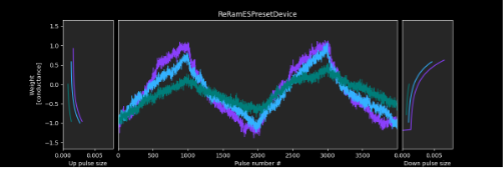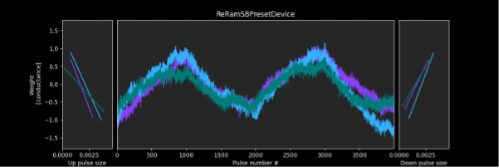Analog Training Presets
The toolkit includes built-in analog presets that implement different types of devices that could be used to implement an analog neural network training. These presets (except “Idealized analog device”) are calibrated on the measured characteristics of real hardware devices that have been fabricated at IBM. Device non-ideal characteristics, noise, and variability are accurately simulated in all presets.
a library of device presets that are calibrated to real hardware data and/or are based on models in the literature.
a library of configuration presets that specify a particular device and optimizer choice.
The current list of device and configuration presets can be found in the
aihwkit.simulator.presets module. These presets can be used directly
instead of manually specifying a RPU Configuration:
from aihwkit.simulator.tiles import AnalogTile
from aihwkit.simulator.presets import TikiTakaEcRamPreset
tile = AnalogTile(10, 20, rpu_config=TikiTakaEcRamPreset())
In what follows we describe in more details the characteristics of some of the Analog training presets. For a comprehensive list
of all available preset configurations, check the aihwkit.simulator.presets.configs module.
ReRAM-ES Preset
Summary: Resistive random-access memory (ReRAM) device based on hafnium oxide using exponential step model.
The example below shows how you can use this preset to create a simple Analog Linear layer network. For more details,
check aihwkit.simulator.presets.configs.ReRamESPreset module:
from aihwkit.simulator.presets import ReRamESPreset
# Define a single-layer network, using the ReRAM-ES preset.
rpu_config = SingleRPUConfig(device=ReRamESPreset())
model = AnalogLinear(4, 2, bias=True, rpu_config=rpu_config)

Resistive random-access memory (ReRAM) is a non-volatile memory technology with tuneable conductance states that can be used for in-memory computing. The conductance change of a ReRAM device is bidirectional, that is, it is possible to both increase and decrease its conductance incrementally by applying suitable electrical pulses. This capability can be exploited to implement the backpropagation algorithm. The change of conductance in oxide ReRAM is attributed to change in the configuration of the current conducting filament which consists of oxygen vacancies in a metal oxide film.
This preset is based upon the ReRAM device presented in the work of Gong et al.:ref:[6] <references>. This device was fabricated with hafnium oxide as the metal oxide switching layer. The preset captures the experimentally measured response of this device to 1000 positive and 1000 negative pulses (shown in the Figure above), including the pulse-to-pulse fluctuations. The movement of the oxygen vacancies in response to electrical signals has a probabilistic nature and it emerges as inherent randomness in conductance changes. Realistic device-to-device variability is also included in the preset to appropriately simulate the behavior of an array of such devices.
The example below shows how you can create a simple Analog neural network using the ReRAM-RS present:
from aihwkit.simulator.tiles import FloatingPointTile
tile = FloatingPointTile(10, 20)
Parameters |
Description |
|---|---|
Number of steps |
1000 |
Conductance update model |
Exponential step |
+/- step max. asymmetry |
-670% |
Step size variability across devices |
20% |
Step-to-step variability on same device |
500% |
Max/min conductance variability |
30% |
Instantaneous write noise per step (in % of weight range) |
5% |
ReRAM-SB Preset
Summary: Resistive random-access memory (ReRAM) device based on hafnium oxide using soft bounds model.
The example below shows how you can use this preset to create a simple Analog Linear layer network. For more details,
check aihwkit.simulator.presets.configs.ReRamSBPreset:
from aihwkit.simulator.presets import ReRamSBPreset
rpu_config=ReRamSBPreset()
model = AnalogLinear(4, 2, bias=True, rpu_config=rpu_config)

This preset is similar ReRAM-SB preset except that it uses a soft bounds model instead of an exponential model. The parameters of this preset as shown in the table below:
Parameters
Description
Number of steps
1000
Conductance update model
Soft Bounds
+/- step asymmetry (at w=0.75)
-400%
Step size variability across devices
30%
Step-to-step variability on same device
375%
Max/min conductance variability
30%
Instantaneous write noise per step (in % of weight range)
5%
Capacitor-cell Preset
Summary: Capacitor-based unit cell device using trench capacitor in 14nm CMOS technology.
For more details, check aihwkit.simulator.presets.configs.CapacitorPreset module.

A capacitor-based cross-point array can be used to train analog neural networks. A capacitor can serve as an analog memory, connected to the gate of a “readout” pFET. During readout, the synaptic weight can be accessed by measuring the conductance of the readout FET. During weight update, the capacitor is charged/discharged by two “current source” FETs, as controlled by two analog inverters and one digital inverter. Charge can be added or subtracted continuously if the number of electrons is high, so analog and symmetric weight update can be achieved. Capacitor-cells have demonstrated some of the best linearity and symmetry characteristics among analog devices, making them a promising candidate for neural network training.
This preset is based upon the capacitor-based cross-point array presented in the work of Li et al.:[7]. The array was fabricated with trench capacitors in 14nm CMOS technology. The preset captures the experimentally measured response of this device to 400 positive update and 400 negative update pulses (shown in Figure 6), including the pulse-to-pulse fluctuations. The reported asymmetry between positive and negative updates of 10% is included as well as the cell-to-cell asymmetry variations. Capacitor leakage is also simulated by exponentially decreasing the weight values over training mini-batches, and cell-to-cell variations in leakage are included. Realistic pulse-to-pulse and device-to-device variability is also included in the preset to appropriately simulate the effect of non-ideal characteristics such as readout variation and variation of current sources.
Parameters |
Description |
|---|---|
Number of steps |
400 |
Conductance update model |
Linear step |
+/- step max. asymmetry |
-10% |
Step size variability across devices |
10% |
Step-to-step variability on same device |
30% |
Max/min conductance variability |
7% |
Leakage (in mini-batches) |
106 |
ECRAM Preset
Summary: Electro-Chemical Random-Access Memory (ECRAM) device based on lithium (Li) ion intercalation in tungsten oxide (WO3).
For more details, check aihwkit.simulator.presets.configs.EcRamPreset module.

Electro-Chemical Random-Access Memory (ECRAM) is a three terminal non-volatile electrochemical switch that has been proposed as an artificial synapse for Analog AI. The electrochemically driven intercalation or redox reaction can be precisely and reversibly controlled by the amount of charge through the gate, so it can provide near-symmetric switching with plentiful discrete states and reduced stochasticity. As a trade-off for cell complexity using three-terminal device, the read and write operations are decoupled, allowing for better endurance and low-energy switching while maintaining non-volatility. These attributes make ECRAM a promising device candidate for neural network training applications.
This preset is based upon the ECRAM device presented in the work of Tang et al.:[7]. Lithium phosphorous oxynitride (LiPON) was used as a solid-state electrolyte. The amount of Li ions intercalated in WO3 is precisely controlled by the gate current and this process is reversible, enabling near-symmetric update. In operation, series of positive (negative) current pulses are fed into the gate for potentiation (depression).The preset captures the experimentally measured response of this device to 1000 positive and 1000 negative pulses (shown in Figure 13 in the paper), including the pulse-to-pulse fluctuations. Realistic device-to-device variability is also included in the preset to appropriately simulate the behavior of an array of such devices.
Parameters |
Description |
|---|---|
Conductance update model |
Linear step |
+/- step max. asymmetry |
-75% |
Step size variability across devices |
10% |
Step-to-step variability on same device |
30% |
Max/min conductance variability |
5% |